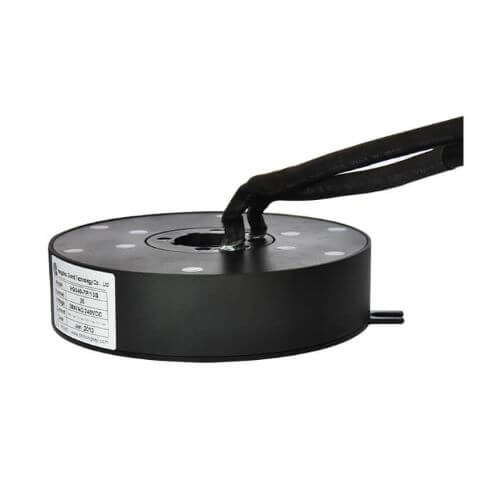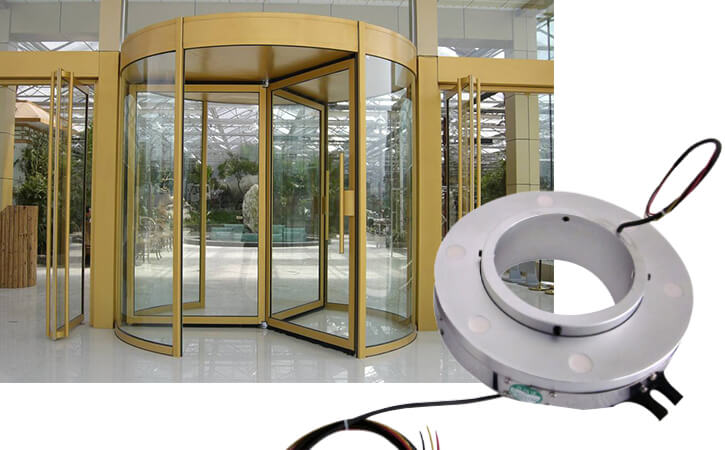This guide walks you through the Essentials of Flat Board Slip Rings, their working principle, common applications, important selection factors, installation, maintenance, and troubleshooting methods. We’ll also delve into future trends of this impressive gadget impacting various industries.
Introduction to Flat Board Slip Rings
Flat board slip rings are a marvel of modern electrical engineering, designed to facilitate uninterrupted electrical connectivity, particularly between stationary and rotating components. These devices have emerged as an excellent solution to conventional slip ring systems’ limitations, setting a new standard for seamless power and data transmission amidst rotational movement.
Flatboard slip rings primarily stand out due to their unique, compact design. Unlike their cylindrical counterparts, these devices are flat – a feature that leads to their primary benefit: space efficiency. This makes them an excellent choice for applications where size and weight restrictions are a crucial consideration. Moreover, their flat design allows for more miniature components to be fitted, providing more connectivity options within the same space and often providing multi-channel capacity.
In addition to their compact design, flat board slip rings offer distinct benefits such as lowered electrical noise, paving the way for a cleaner, more reliable signal. This makes them particularly useful in sensitive applications where accuracy and preciseness of data transmission are paramount.
Another distinguishing feature of these devices is their superior durability and long service life. Precisely engineered, they are built to withstand significant wear and tear, further promoting efficient functionality across different applications and environments.
In essence, flat board slip rings represent an innovative solution that caters to the evolving demands of various industries, characterized by their robustness, compactness, and ability to deliver efficient, reliable signal transmission.

Working Principle of Flat Board Slip Rings
The core functionality of flat board slip rings is rooted in their ability to facilitate the transmission of electrical power and signal from a stationary to a rotating structure, and vice versa. This sophisticated feat is accomplished through the basic working principle of these devices, which centers around constant physical electrical contact during rotation.
The central component of a flat board slip ring is the slip ring contact, which is usually constructed of highly conductive metal and mounted on a flat disc. As the disc spins, it carries with it the electrical and signal connections that must be maintained during rotation.
Cooperating with the slip ring contact is the brush, comprised of a metal or carbon graphite material and held against the slip ring with a spring, ensuring consistent contact. As the slip ring contacts rotate, the brushes remain stationary, allowing for the transferring of electric current or signal. Herein lies the fundamental characteristic of flat board slip rings: the ability to maintain constant connectivity even amidst ongoing motion.
Integral to this system is the printed circuit board (PCB). The PCB plays a critical role in flat board slip rings, routing electric current or data signals from the stationary part to the brushes and from the brushes to the rotating section. The design of the PCB allows for multi-channel transmissions within the compact space of a flat board slip ring.
In essence, the ingenuity of flat board slip rings lies in the harmony of all these components. Their working principle redefines mechanical boundaries and opens up a world of possibilities, enabling seamless and continuous electrical transmission between rotating and stationary systems.
Common Applications of Flat Board Slip Rings
The unique benefits of flat board slip rings have led to their adoption in a wide array of industries and applications where the ability to transmit signals or power amidst rotation is required.
One of the most prominent sectors utilizing these devices is the renewable energy industry, specifically in wind turbines. Here, flat board slip rings provide a crucial role in transmitting power and data signals from the rotating turbine blades to the stationary base while maintaining constant operation amidst rotational movement.
Similarly, in the realm of telecommunications, radar antennas heavily depend on flat board slip rings’ unique prowess. As the radar antenna oscillates for capturing signals, flat board slip rings ensure uninterrupted transmission of power and detection data, thereby facilitating efficient and robust communication flows.

Flat board slip rings also find usage in modern testing equipment. Be it automotive testing machines or robust industrial process testing setups, these slip rings facilitate a seamless interface that continuously delivers data despite the constant rotation, ensuring accurate and real-time data acquisition.
In the manufacturing world, applications like cable reels and rotary tables require continuous and unrestrained rotation while providing power or transmitting data. Flat board slip rings have emerged as an ideal fit, confidently meeting these demanding criteria.
In all these applications and many more, flat board slip rings positively affect performance in several ways. Their compact design means they can fit within limited spaces, providing solutions in scenarios where conventional slip rings would fall short. Furthermore, their distinctive ability to reduce electrical noise ensures more reliable, cleaner signals, enhancing the overall effectiveness of the application. This, coupled with their long lifespans, brings about significant operational efficiencies and reduced downtime, thereby amping up overall productivity.
In summary, the applications of flat board slip rings are vast, varied, and growing. They’ve become an essential component in multiple fields, revolutionizing how we engage and interact with rotating mechanisms.
Important Selection Factors for Flat Board Slip Rings
Choosing the right flat board slip ring is a critical aspect that directly affects the performance and efficiency of an application. There are several factors to consider when selecting these devices, chiefly among them being size, channels, material, and load capacity.
Considering the size is essential due to the varying dimensions of flat board slip rings that manufacturers offer. The necessary size directly corresponds to the space available in your assembly. It’s crucial to consider both the footprint (outer diameter) and the inner diameter to ensure the slip ring can comfortably fit within the operating environment.
Channels, or the number of circuits a slip ring can handle, is another vital factor. This dictates how much power and how many data signals the slip ring will transmit simultaneously. The correct number of channels depends on how many independent power and signal pathways your application requires.
The material of flat board slip rings is crucial for robustness and longevity. Contacts are typically made from metals like gold that offer superior conductivity and minimal oxide deposition. The type of brush material – sometimes also gold or silver graphite – can affect the current-carrying capacity and life expectancy of the slip ring, so it’s essential to choose wisely.
Finally, the load capacity or the peak electricity the device can transmit should be adequately matched to the application’s demands. Overloading a slip ring not designed for such a load can lead to rapid deterioration or device failure. Thus, understanding your application’s power requirements is paramount.
The implications of selecting the correct flat board slip ring are enormous. A well-suited slip ring can ensure seamless operation, promote extended equipment lifespan, and enhance overall efficiency. However, a poorly chosen slip ring can cause frequent disruptions, lead to accelerated wear and tear, and ultimately result in a potential system failure.
In summary, choosing the right flat board slip ring revolves around understanding the application’s specifics, thoroughly analyzing the slip ring’s capabilities, and striking a pragmatic balance between the two.
Installation and Maintenance Tips for Flat Board Slip Rings
Installing and maintaining flat board slip rings plays a crucial role in maximizing their efficiency and lifespan. Here are some general guidelines:
Installation Guidelines
- Proper Alignment: Maintaining proper alignment between the stationary and rotating parts is vital. Misalignment can cause excessive wear and drastically bring down the lifespan of the device.
- Securing Fasteners: Ensure all mounting screws, bolts, or other fasteners are adequately tightened to provide a solid base and to avoid erratic movement during operation.
- Correct Cable Connection: Follow the manufacturer’s instructions carefully to correctly wire and connect the cables for power and signals. Incorrectly connected cables can cause functional failures and could potentially lead to safety hazards.
- Test Operation: After installation, conduct a test run to ensure smooth operation. Address any issues observed, such as unusual noise or difficulty in rotation, before initiating full-scale operation.
Maintenance Tips
- Regular Cleaning: Conduct regular cleaning of the brushes and slip ring contacts to remove dust, debris, or oxide build-up. This aids in maintaining good electro-mechanical contact and reduces electrical noise.
- Visual Inspection: Regularly inspect the slip rings forwear and tearr. This includes check-ups for any discoloration of the contact surface, uneven brush wear, or physical abrasions, all of which might indicate an issue that needs addressing.
- Load Monitoring: Regularly monitor the electrical load during operation. Overloading can create excessive heat leading to premature wear or damage.
- Lubrication: If the slip ring design permits, apply the recommended lubrication to enhance the slip ring and brush interaction, subsequently leading to a more extended lifespan and smoother rotation.
By adhering to these guidelines and tips, it is possible to install your flat board slip rings for optimal use and maintain them effectively to prolong their lifespan. Always remember, that a well-maintained slip ring can significantly improve the performance and reliability of the application it supports.
Troubleshooting Common Issues with Flat Board Slip Rings
In the course of using flat board slip rings, a few common problems may manifest. However, by recognizing these issues promptly and taking the necessary steps, one can resolve these challenges effectively, ensuring the smooth operation of the device. Here’s a look at some of these issues and potential solutions:
Issue #1: Irregular or Intermittent Signal
This can be due to dirty or oxidized contact surfaces, worn-out brushes, or improper alignment between the slip ring and the brush.
Solution:
Regularly clean the contact surfaces of the slip ring and brushes and consider replacing any worn-out parts. Ensure proper alignment of the brush and the ring for optimal operation.
Issue #2: Overheating
This could result from overloading the slip ring beyond its capacity or from increased friction due to improper lubrication or alignment.
Solution:
Ensure the slip ring is not overloaded beyond its specified ratings. Regularly check and adjust alignment and lubrication levels as necessary.
Issue #3: Excessive Noise or Vibration
This might be an indicator of mechanical issues such as loose mounting components, misalignment, or worn-out parts.
Solution:
Inspect mounting hardware for looseness and tighten it if necessary. Check alignment and replace any parts showing substantial wear.
Issue #4: Short Lifespan
This could be a result of several factors such as overloading, poor maintenance, or harsh operating conditions.
Solution:
Ensure the slip ring is not overloaded, conduct regular maintenance such as cleaning and lubrication, and try to optimize the operating environment as much as possible.
Issue #5: Corrosion
This issue occurs when slip rings are exposed to corrosive environments or liquids and can lead to the degradation of contacts and brushes.
Solution:
Shield the slip ring if operating in corrosive environments or clean the contacts and brushes regularly to remove any corrosion. In severe cases, consider slip rings with contacts and brushes made from corrosion-resistant materials.
In summary, troubleshooting the common issues with flat board slip rings requires a thorough understanding of their working and familiarity with their specific operational and maintenance protocols. Regular inspection and immediate response to any anomalies can avoid major breakdowns and contribute to the long-term efficiency and lifespan of these devices.
Future Trends and Developments in Flat Board Slip Rings
As we advance technologically, the scope for improvement and innovation in flat board slip ring technology is vast, and we can expect significant developments that would shape the future of various industries.
Expected Trends and Advancements
- Miniaturization: As devices become smaller and more compact, the trend towards miniaturized flat board slip rings is expected to continue, especially for application areas like robotics, drones, and medical equipment where reduced size and weight are crucial.
- Increased Capacity: With growing data and power transmission demands, we can anticipate improvements in slip ring design to accommodate more circuits without increasing size, allowing for higher capacity transmission.
- Improved Materials: Ongoing research into new materials and alloys promises the development of more durable, efficient, and reliable slip rings with properties such as increased electrical conductivity and wear resistance.
- IoT Integration: With the rise of Industry 4.0 and the Internet of Things (IoT), there’s potential for smart slip rings capable of self-diagnostics, predictive maintenance, and integration into wider control systems.
Potential Impact on Industries and Applications
These advancements would undoubtedly have profound implications across various sectors:
- Industrial Automation: Enhanced slip rings would result in more efficient, reliable, and compact automated machinery. This means reduced downtime, increased productivity, and lower maintenance costs.
- Aerospace & Defense: The miniature, high-capacity flat board slip rings would prove transformative in drones and other military equipment where size, weight, and efficiency are factors of paramount significance.
- Medical Field: These developments could facilitate the creation of smaller and more efficient medical devices and equipment, thus enhancing healthcare delivery.
- Renewable Energy: High-capacity, durable slip rings can significantly contribute to the efficiency of wind turbines and other renewable energy setups, thereby promoting the growth of green energy.

In conclusion, the future of flat board slip ring technology promises exciting advancements influencing a multitude of sectors. By enhancing efficiency, reliability, and capacity, these developments could drive a significant transformation in how we utilize and perceive slip ring technology.
Conclusion
Understanding flat board slip rings—from working principles to implementation—is essential for making informed decisions and usage. As technology advances, staying abreast of future trends can help in leveraging these innovations to your advantage.
FAQs about Flat Board Slip Rings
Q: How do flat board slip rings differ from traditional cylindrical slip rings?
A: Flat board slip rings are known for their thin, compact design which makes them an ideal choice for applications with limited space. They often provide multi-channel capacity, better noise reduction, and are typically more efficient in energy consumption compared to their cylindrical counterparts.
Q: What factors affect the operating life of a flat board slip ring?
A: The operating life of a flat board slip ring depends on several factors, including the material of the contacts and brushes, load capacity, maintenance practices, work environment, and frequency of use. Proper care, maintenance, and selecting a high-quality slip ring can extend its lifespan significantly.
Q: Can flat board slip rings be customized for specific applications?
A: Yes, many manufacturers offer customizable flat board slip rings to meet individual application requirements. By working closely with the supplier, one can tailor the slip ring with the desired channels, materials, and dimensions for optimal performance.
Q: How do I identify the appropriate size and capacity for my application?
A: It is essential to analyze the specific needs of your application thoroughly. Assess the available space and required power or signal transmission capabilities to determine the appropriate size and capacity of the flat board slip ring. Consulting with an experienced manufacturer can help guide you in making a well-informed decision.
Q: What are some maintenance procedures for flat board slip rings?
A: Regular maintenance procedures for flat board slip rings include cleaning the contacts and brushes, inspecting for wear and tear, and monitoring overall system performance. Periodic checks on load capacity, alignment, and brush pressure are also helpful in prolonging the life of the slip ring.
See What We Can Do

